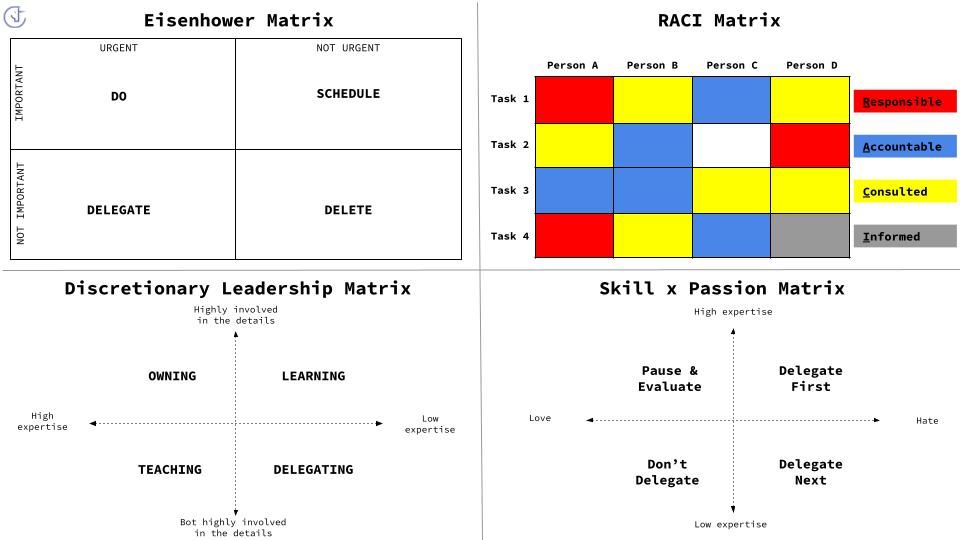➕ Delegation Matrix
Let’s talk about Delegation Matrixes.
🤔 Why you should care about it
“Picture this. I am your supervisor, and I walk over to you with pencil in hand and tell you to take it. You reach for the pencil, but I won’t let go. So I say, “What is wrong with you? Why can’t I delegate the pencil to you?” We all have some things that we don’t really want to delegate simply because we like doing them and would rather not let go.” - Andrew Grove, Hungarian-American businessman and engineer, former Intel CEO.
When their team grows, CTOs and engineering leaders often struggle to identify what they can delegate, to whom and how to ensure that the delegated tasks will be completed as expected. Engineering leaders can use delegation matrixes to help them efficiently allocate their time and efforts to avoid spending too much time making those decisions or making the wrong decisions.
😫 Problem(s)
WHAT —> It’s challenging to identify which tasks can be delegated without impacting the team’s productivity too much. Should we delegate tasks for which we have little knowledge or, on the contrary, for which we are experts?
WHO —> It’s tempting to always delegate tasks to those who are experts are conducting them, but doing so prevents newcomers or junior engineers from becoming more competent and creates more pressure on a few team members.
HOW —> As Andrew Grove says, “delegation without follow-through is abdication.” But how to efficiently measure the success of a delegated task without micro-managing?
😃 Solution(s)
A delegation matrix is a mental model used by team leaders or members to help them decide which tasks to delegate and to whom. There are several delegation matrixes, including:
Eisenhower Matrix —> also known as the Urgent-Important Matrix, helps you decide on and prioritise tasks by urgency and importance.
RACI Matrix —> the responsibility assignment matrix describes the roles and responsibilities of a project’s participant for each task.
Discretionary Leadership Matrix —> developed by Apple, this model helps team leaders where and how they spend their time and efforts.
Skill x Passion Matrix —> this matrix helps team leaders decide which tasks to delegate based on their competence and passion levels.

💡 Key Concepts
Delegation —> the activity of transferring a task’s ownership to a team member, where the “delegator” and “delegatee” share a joint information base and a standard set of operational ideas on how to solve problems.
Micromanagement —> management with excessive control or attention to small details, illustrating the manager's lack of freedom and trust.
Mental model —> intellectual tool or framework, similar to algorithms, allowing us to make sense of a situation or solve a problem.
😡 Disadvantages
All delegation matrixes above have significant disadvantages:
- The Eisenhower matrix prevents team leaders from delegating urgent and essential tasks, but most tasks are urgent and essential when you’re in a high-growth company. Team leaders hence become Single Points Of Failure.
- The RACI matrix is long and complex to set up and does not help decide when dealing with exceptions. Also, it disempowers most team members who are not Responsible or Accountable.
- The discretionary leadership model is misinterpreted as micro-management since team leaders must be highly involved in the details.
- The skill x passion matrix is the worst since team leaders would never be able to delegate tasks they love doing.
📚 Top book
Turn The Ship Around!: A True Story of Building Leaders by Breaking the Rules - L. David Marquet
⚙️ Top Templates
Eisenhower matrix Notion template - Notion (free)
Key Responsibilities, RACI Notion template - Brian Royce (free)
📝 Top Content
📝 How Apple Is Organized for Innovation - Joel M. Podolny and Morten T. Hansen --> How Apple team leaders are also highly expert, and how it scales.
📺 Turn the Ship Around - L. David Marquet --> David Marquet's talk at Google (watch until 5:01 if you don't have the time to watch everything).
📝 ‘Give Away Your Legos’ and Other Commandments for Scaling Startups - Molly Graham --> A very interesting framework to avoid blocking an organisation's growth because of our love of what we're currently doing.
